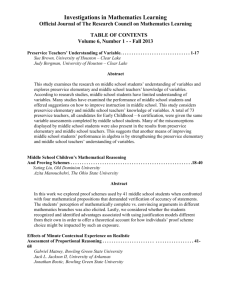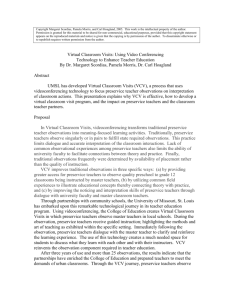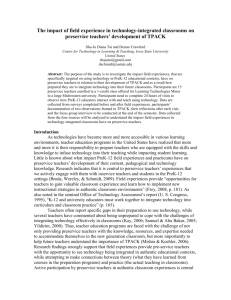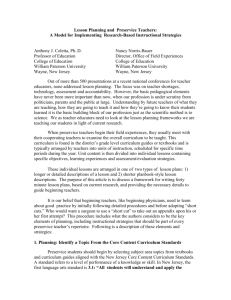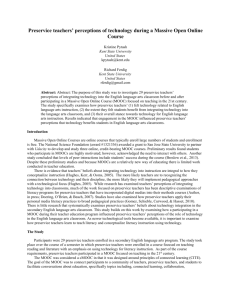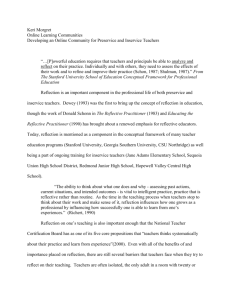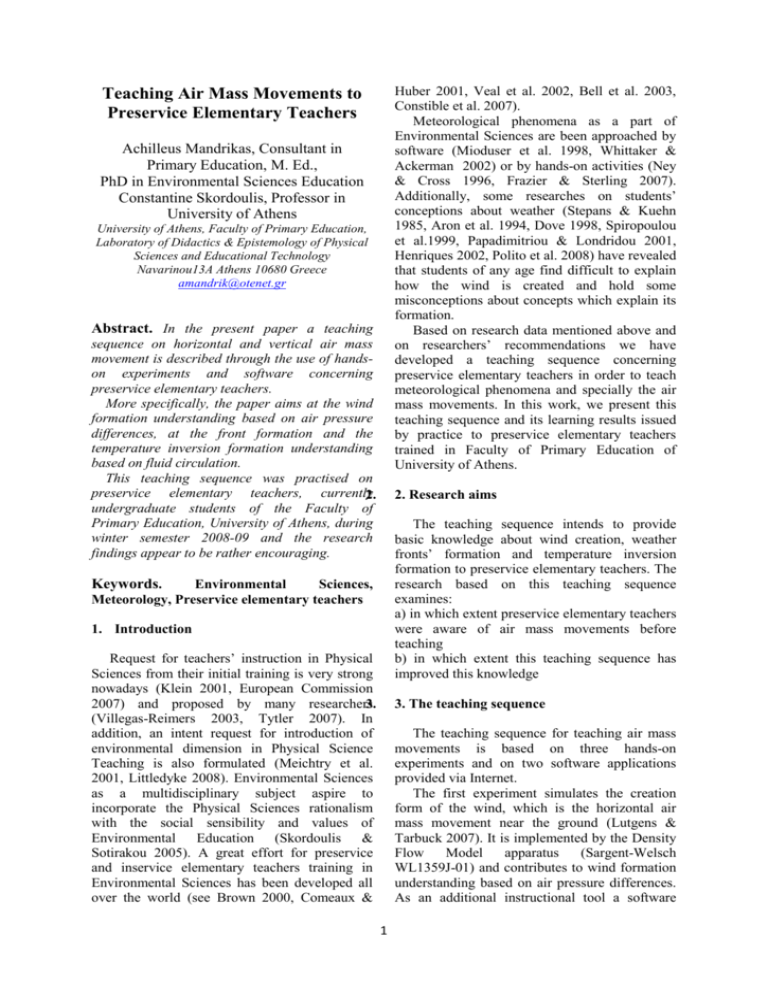
Huber 2001, Veal et al. 2002, Bell et al. 2003,
Constible et al. 2007).
Meteorological phenomena as a part of
Environmental Sciences are been approached by
software (Mioduser et al. 1998, Whittaker &
Ackerman 2002) or by hands-on activities (Ney
& Cross 1996, Frazier & Sterling 2007).
Additionally, some researches on students’
conceptions about weather (Stepans & Kuehn
1985, Aron et al. 1994, Dove 1998, Spiropoulou
et al.1999, Papadimitriou & Londridou 2001,
Henriques 2002, Polito et al. 2008) have revealed
that students of any age find difficult to explain
how the wind is created and hold some
misconceptions about concepts which explain its
formation.
Based on research data mentioned above and
on researchers’ recommendations we have
developed a teaching sequence concerning
preservice elementary teachers in order to teach
meteorological phenomena and specially the air
mass movements. In this work, we present this
teaching sequence and its learning results issued
by practice to preservice elementary teachers
trained in Faculty of Primary Education of
University of Athens.
Teaching Air Mass Movements to
Preservice Elementary Teachers
Αchilleus Mandrikas, Consultant in
Primary Education, M. Ed.,
PhD in Environmental Sciences Education
Constantine Skordoulis, Professor in
University of Athens
University of Athens, Faculty of Primary Education,
Laboratory of Didactics & Epistemology of Physical
Sciences and Educational Technology
Navarinou13A Athens 10680 Greece
amandrik@otenet.gr
Abstract. In the present paper a teaching
sequence on horizontal and vertical air mass
movement is described through the use of handson experiments and software concerning
preservice elementary teachers.
More specifically, the paper aims at the wind
formation understanding based on air pressure
differences, at the front formation and the
temperature inversion formation understanding
based on fluid circulation.
This teaching sequence was practised on
preservice elementary teachers, currently
2.
undergraduate students of the Faculty of
Primary Education, University of Athens, during
winter semester 2008-09 and the research
findings appear to be rather encouraging.
2. Research aims
The teaching sequence intends to provide
basic knowledge about wind creation, weather
fronts’ formation and temperature inversion
formation to preservice elementary teachers. The
research based on this teaching sequence
examines:
a) in which extent preservice elementary teachers
were aware of air mass movements before
teaching
b) in which extent this teaching sequence has
improved this knowledge
Keywords.
Environmental
Sciences,
Meteorology, Preservice elementary teachers
1. Introduction
Request for teachers’ instruction in Physical
Sciences from their initial training is very strong
nowadays (Klein 2001, European Commission
2007) and proposed by many researchers
3.
(Villegas-Reimers 2003, Tytler 2007). In
addition, an intent request for introduction of
environmental dimension in Physical Science
Teaching is also formulated (Meichtry et al.
2001, Littledyke 2008). Environmental Sciences
as a multidisciplinary subject aspire to
incorporate the Physical Sciences rationalism
with the social sensibility and values of
Environmental Education (Skordoulis &
Sotirakou 2005). A great effort for preservice
and inservice elementary teachers training in
Environmental Sciences has been developed all
over the world (see Brown 2000, Comeaux &
3. The teaching sequence
The teaching sequence for teaching air mass
movements is based on three hands-on
experiments and on two software applications
provided via Internet.
The first experiment simulates the creation
form of the wind, which is the horizontal air
mass movement near the ground (Lutgens &
Tarbuck 2007). It is implemented by the Density
Flow
Model
apparatus
(Sargent-Welsch
WL1359J-01) and contributes to wind formation
understanding based on air pressure differences.
As an additional instructional tool a software
1
application
provided
at
http://www.phys.ufl.edu/~matchev/MET1010/no
tes/ ActiveFigures/A_54_files/A_54.swf is used.
The second experiment simulates the
horizontal movements of air mass with different
temperature and the following weather front
formation. It is also implemented by the Density
Flow
Model
apparatus
(Sargent-Welsch
WL1359J-01) and is accompanied by appropriate
slides on the computer screen.
The third experiment is implemented by the
Air Mass Generator apparatus (Sargent-Welsch
WL6837E) and simulates the vertical air mass
movements, which increase or reduce air
pollution in relation with temperature differences
among air layers. This experiment intends to the
understanding of the temperature inversion
formation, in the case that the vertical air mass
movement is failed. For better explanation the
experiment is accompanied by a software
application provided at http://www.airinfonow.
com /html/activities.html.
The didactical methodology we espoused is
the guided inquiry (Minstrell & Van Zee 2000).
The preservice elementary teachers followed a
step by step procedure of hands-on and written
activities as they complete an appropriate
instructional sheet.
assessment. As well, they ignored weather fronts
and temperature inversion concepts. In great
majority they declared that they had nothing
learnt about wind during their schooling. Our
teaching sequence is seemed to have reform in
satisfactory degree these deficiencies.
Table 1. Total answers about wind formation
How the
Before
After teaching
wind is
teaching
created?
Num.
Perce Num.
Perce
of p.t. ntage of p.t.
ntage
n=60
n=60
I don’t know
39
65%
8
13%
Unprincipled
10
16%
5
8%
answers
By
7
12%
13
22%
temperature
differences
By airstreams 2
3%
5
8%
By barometric 1
2%
7
12%
systems
By air
1
2%
22
37%
pressure
differences
The same question “How the wind is
created?” has been included both in pre-test and
post-test in order to check first aim’s
achievement. In the pre-test 65% of preservice
teachers has answered “I don’t know” and only
one has mentioned air pressure differences as the
cause of the wind (Table 1). In the post-test 37%
of preservice teachers gave the correct answer:
“Wind is created by air pressure differences
between two areas” (PT22). Furthermore, most
of them overstate the precise direction of the
movement and discriminate between vertical and
horizontal movements. In addition, only 13%
declared “I don’t know” and unprincipled
answers reduced from 16% to 8%.
However, this result could be improved given
that many answers reveal confusion of concepts
and various misconceptions. 22% of preservice
teachers continue to consider temperature
differences as the cause of the wind. They likely
confuse surface horizontal air movements, which
actually constitute the wind, with vertical air
movements, which are caused by temperature
differences and come before horizontal
movements. “The wind is created when warm air
masses lay upwards and cold air masses lay
downwards creating airstreams” (PT24).
Obviously, this answer contents some right
elements, though their correlation cannot explain
wind formation in an acceptable scientific way.
4. Research methodology
The teaching sequence mentioned above was
practised on 60 preservice elementary teachers,
currently undergraduate students of the Faculty
of Primary Education, University of Athens,
during winter semester 2008-09 in the elective
lesson named “Physical Sciences & Environment
– A laboratory approach”.
For data gathering have been used a)
questionnaires accomplished a week ago and a
week after the instruction b) instructional sheets
accomplished during the activities c) recorded
discussions among preservice teachers in the
whole class d) recorded interviews given after
instruction. Data processing has been elaborated
by
semantic
content
analysis
method
(Vamvoukas 1988).
5. Results and discussion
From data analysis is evident that preservice
elementary teachers before the instruction
possessed a poor cognition of wind mechanism
creation, of wind naming, of orientation pattern
and of wind direction and wind velocity
2
one: “A cold weather front is created when a
cold air mass pushes a warm air mass” (PT27).
Some of them try to explain this violent push: “A
cold front is created when cold air waves because
of their heaviness approach land surface pushing
warm air waves upwards” (PT30). Furthermore,
others mention the final physical result of this
push: “…the warm air suddenly freezes and
shortly precipitates, as a result rainstorms of
short duration occur” (PT44) (Table 3).
However, approximately a half of preservice
teachers denote wrong causes for fronts’
formation. 10% consider that fronts are formed
because of cold airstreams. 7% notice that fronts
accompany barometric systems. 7% attribute
cold front formation to low temperature of the
ground and another 5% make a wider correlation
of the cold front with low temperature. 5%
describe wrongly the warm front formation, 3%
describe mistakenly the wind formation and 10%
give various unprincipled answers proclaiming
wider problems in Physical Science concepts
management.
During the interviews preservice teachers
recognized that they confuse concepts and
phenomena. At first, air masses don’t “have”
high or low barometric system, but they generate
high or low barometric pressure. Then, it is not
simplified the precise “movement which is
created”, namely if it concerns an upward
movement of warm air masses caused by cold
ones or only an upward movement of warm air
masses. In addition, the “removal” which is
created it is not declared either is vertical or
horizontal.
Finally, 25% of preservice teachers gave the
answer “I don’t know” to the question about
front formation in the post-test, a fact that
confirms the great difficulties that preservice
teachers encountered in this issue.
From such a formulation we estimate that
three kinds of conclusions are inferred. At first,
some
preservice
teachers
speak
with
macroscopic terms and usually describe only the
observable result of the experiment, because they
cannot give a full explanation based on
appropriate scientific concepts concerning fluid
circulation. Then, some preservice teachers don’t
discriminate between vertical and horizontal
movements, because they cannot discriminate
between temperature differences and air pressure
differences. Finally, confusion between cause
and consequence is established, namely some
preservice teachers believe that the existence of
high barometric pressure causes air downdraught movement, while in reality the air downdraught movement creates high barometric
pressure on the surface.
Table 2. Answers about weather fronts’
formation before teaching
When a warm air mass
Num. of Perce
arises over a cold air mass is p.t.
ntage
formed:
n=60
Α. A cold weather front
12
20%
Β. A warm weather front
13
22%
C. Sea breeze
9
15%
D. I don’t know
26
43%
Concerning the fronts’ formation in the pretest 43% of preservice teachers ignored the
phenomenon and only 22% selected the right
answer (Table 2).
Table 3. Answers about fronts’ formation
after teaching
How a cold weather front is Num. of
Percen
formulated?
p.t.
tage
n=60
By violent push of the
17
28%
warm air mass by the cold
I don’t know
15
25%
Unprincipled answers
6
10%
By cold airstreams
6
10%
By barometric systems
4
7%
Because of low
4
7%
temperature of the ground
Because of low
3
5%
temperature
Explain of warm front
3
5%
Explain of wind formation
2
3%
Table 4. Answers about temperature inversion
before teaching
Temperature invrrsion is
Num.
Percent
formed when:
of p.t.
age
n=60
Α. a warm and a cold air layer 11
18%
run across each other
Β. a cold air layer is trapped
3
5%
between two warmer layers
C. a warm air layer is trapped 2
3%
between two colder layers
D. I don’t know
44
73%
In the post-test 28% of preservice teachers
can describe in an open question how a cold
weather is generated. Most of them focus on the
violent push of the warm air mass by the cold
Concerning the temperature inversion, 73%
of preservice teachers ignored that concept
3
before teaching and only 3% gave the right
answer, namely the inversion occurs when a
warm air layer is trapped between two colder air
layers (Table 4). This percentage was expected to
be higher, given that temperature inversion is a
meteorological phenomenon frequently appeared
into closed basins like Athens and often
presented in the media as a cause of high
pollutants’ concentrations. This is the reason of
special announcements by the state in order to
reduce local air pollution in a great city.
In the post-test preservice teachers had to
recognize temperature inversion on a picture and
to spot its causes. A great improvement has been
marked in this issue. 52% of preservice teachers
selected the right answer, a result much better
than 3% before teaching (Table 5).
inversion with air pollution in a visual way. In
reverse, there wasn’t an analogous visual impact
concerning the causes of the inversion but only
verbal correspondence of the cold water in the
apparatus with the frozen ground reflecting heat.
So, it was more complex for someone to label
the outcome “sudden freezing of the ground
during nights without clouds”.
6. Conclusions
The teaching sequence we have developed
seems to promote concepts’ management
concerning air mass movements. In particular, it
has a strong contribution to wind mechanism
understanding, wherein the main difficulties of
the preservice teachers were the lack of
distinction between horizontal and vertical air
mass movements, the underline of their different
causes and the confusion between cause and
consequence concerning air pressure existence
and air mass movement.
A lower amelioration has been marked in
front formation’s understanding, wherein the
preservice teachers’ difficulties are yield on
wider problems concerning Science Teaching
Education.
Nevertheless, a great improvement has been
remarked in temperature inversion understanding
and its consequences.
In conclusion, this research though
improvement in teaching aims ascertains the
need of greater familiarization of preservice
teachers with Science Teaching through handson activities, as a prerequisite step for better
understanding Environmental Sciences.
Table 5. Answers about the cause of
temperature inversion after teaching
What is the cause of the
Num.
Percent
meteorological phenomenon
of p.t.
age
presented in the picture?
n=60
Α. the temperature difference 23
38%
between sea and land
Β. sudden freezing of the
31
52%
ground during nights without
clouds
C. the increased temperature
5
8%
of the air
D. I don’t know
1
2%
To another question of the post-test 87% of
preservice teachers substantiate that they know
the consequences of temperature inversion and
connect it with air pollution increase (Table 6).
Table 6. Answers about the consequences of
temperature inversion after teaching
Temperature inversion
Num.
Percent
occurrence over a city:
of p.t.
age
n=60
Α. increases air pollution
52
87%
Β. increases air temperature
4
7%
C. increases ground
3
5%
temperature
D. I don’t know
1
2%
7. References
[1] Aron R.H., Francek M.A., Nelson B.D. &
Bisart
W.J.
(1994).
Atmospheric
Misconceptions, Science Teacher, 61, 1, 3033
[2]Bell C., Shepardson D., Harbor J., Klagges
H., Burgess W., Meyer J. & Leuenberger T.
(2003). Enhancing teachers' knowledge and
use of inquiry through environmental science
education. Journal of Science Teacher
Education, 14, 1, 49-71
[3] Brown F. (2000), The Effect of an InquiryOriented Environmental Science Course on
Preservice Elementary Teachers' Attitudes
about Science. Journal of Elementary
Science Education, 12, 2, 1-6
The variety between right answers
concerning the causes (52%) and the
consequences (87%) of temperature inversion
could be attributed to the intent visual impact of
the third experiment. Preservice teachers had
carefully observed the smoke produced by the
flamed match to be accumulated near the ground,
so they have strongly connected temperature
4
[4] Comeaux P. & Huber R. (2001). Students as
Scientists: Using Interactive Technologies
and
Collaborative
Inquiry
in
an
Environmental Science Project for Teachers
and Their Students. Journal of Science
Teacher Education, 12, 4, 235-252
[5] Constible J.M., McWilliams R.G., Soldo
E.G., Perry, B.E. & Lee, R.E. Jr. (2007). An
Immersion
Professional
Development
Program in Environmental Science for
Inservice Elementary School Teachers.
Journal of Geoscience Education, 55, 1, 7279
[6]Dove J. (1998). Alternative Conceptions
about the Weather. School Science Review,
79, 289, 65-69
[7]European Commission (Rocard Μ., Csermely
P., Jorde D., Lenzen D., Walberg-Henriksson
H. & Hemmo V. eds.) (2007), Science
Education NOW: A Renewed Pedagogy of
the
Future
of
Europe,
European
Commission/Directorate-General
for
Research/Directorate L - Science, Economy
and Society, Unit L4, Brussels, EUR 22845
[8]Frazier W. M. & Sterling D. R. (2007).
Weather Tamers, Science Scope, 30, 7, 2631
[9]Henriques L. (2002). Children's Ideas about
Weather: A Review of the Literature. School
Science and Mathematics, 102, 5, 202-215
[10]Klein B. S. (2001), Guidelines for effective
elementary science teacher inservice
education. Journal of Elementary Science
Education, 13(2), 29-40
[11]Littledyke Μ. (2008). Science education for
environmental awareness: approaches to
integrating cognitive and affective domains.
Environmental Education Research, 14, 1, 1–
17
[12]Lutgens F. K. & Tarbuck E. J. (2007). The
Atmosphere,
An
Introduction
to
Meteorology, 10th Ed., New Jersey, Pearson
Prentice Hall, USA
[13]Meichtry Y., Zint M., Carlsen W., Hart P.,
Sammel A., Zandvliet D. & Dillon J. (eds)
(2001). Relations between Science Education
and Environmental (Science) Education - A
NARST Symposium (History, Philosophy,
Epistemology), March 27, 2001
[14]Mioduser D., Venezky R.L. & Gong B.
(1998). The Weather Lab: An InstructionBased Assessment Tool Built From a
Knowledge-Based System. The Journal of
Computers in Mathematics and Science
Teaching, 17, 2-3, 239-263
[15]Ney C. R. & Cross P. (1996). Connections:
Weather, Systems and Resources. Unit
Grade 4, Meeting the SOLS using Natural
Resources. Available at http://www.bev.net/
education/schools/ces/connect.html
[16]Papadimitriou V. & Londridou P. (2001). A
Cross-Age Study of Pupils' Conceptions
Concerning the Movement of Air Masses in
the Troposphere.
In:
Science and
Technology Education: Preparing Future
Citizens. Proceedings of the IOSTE
Symposium in Southern Europe (1st,
Paralimni, Cyprus, April 29-May 2, 2001)
[17]Polito E., Tanner K. D. & Monteverdi J. P.
(2008). Assessing middle school and college
students' conceptions about tornadoes and
other weather phenomena. Paper presented at
24th Conference on Severe Local Storms,
Savannah, Georgia, October 26-30, available
at
http://ams.confex.com/ams/pdfpapers/
141857.pdf
[18]Skordoulis C. & Sotirakou Μ. (2005).
Environment: Science and Education. Leader
Books, Athens (in greek)
[19]Spiropoulou D., Kostopoulos D. & Jacovides
C. P. (1999). Greek Children's Alternative
Conceptions on Weather and Climate.
School Science Review, 81 (294), 55-59
[20]Stepans J. & Kuehn C. (1985). What
research says: Children's conceptions of
weather. Science and Children, 23, 1, 44-47.
[21]Tytler R. (2007), Re-imagining Science
Education: Engaging students in science or
Australia’s future, Australian Education
Review Number 51. Camberwell, Victoria:
ACER Press, available at http://www.acer.
edu.au/documents/AER51_ReimaginingSciE
du.pdf
[22]Veal W.R., Kubasko D.S. Jr. & Fullagar P.
(2002). Web Based Course on Earth and
Environmental Science for Preservice and
Inservice Teachers. Journal of Science
Teacher Education, 13, 2, 131-146
[23]Vamvoukas Μ. Ι. (1988), Introduction to
Psychopedagogic
Research
and
Methodology, Grigoris, Athens (in greek)
[24]Villegas-Reimers E. (2003), Teacher
professional development: an international
review of the literature, UNESCO:
International Institute for Educational
Planning, Paris
[25]Whittaker T.M. & Ackerman S.A. (2002).
Interactive Web-based learning with Java.
Bulletin of the American Meteorological
Society, 83, 7, 970-975
5


